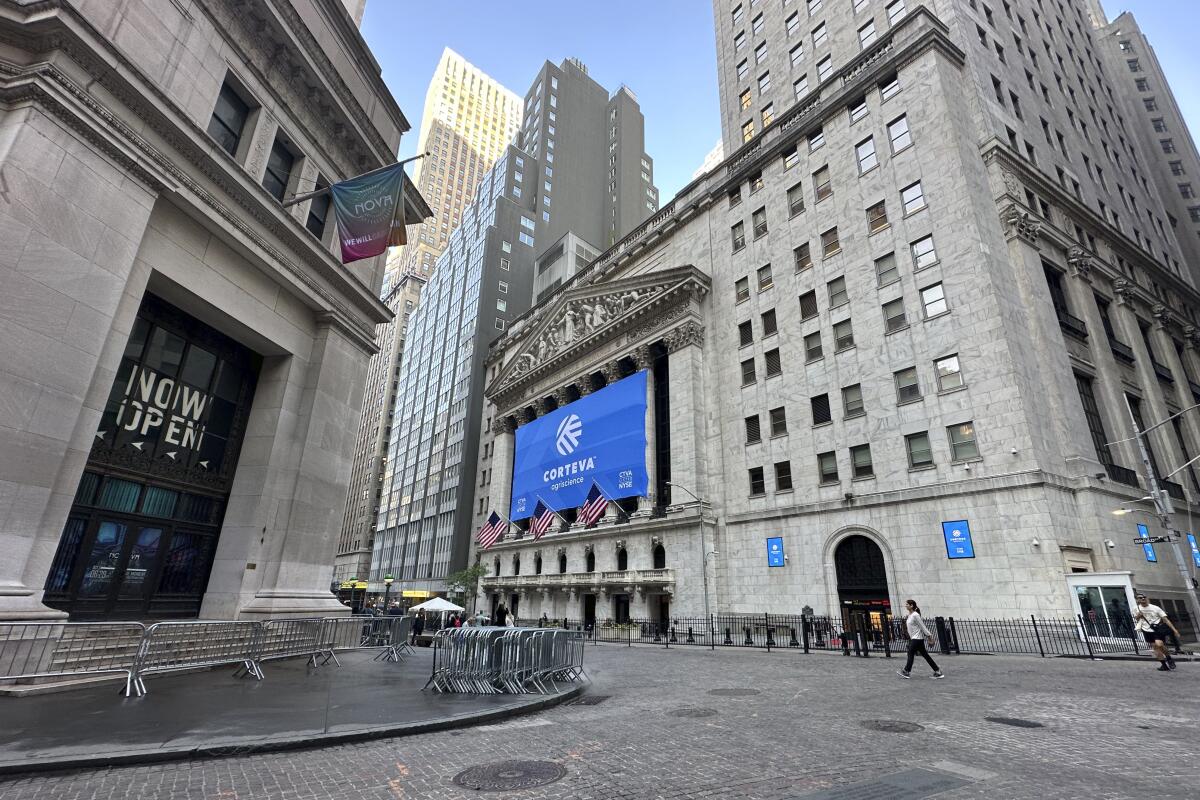Wall Street cleaves between winners and losers on report showing slowing economy

- Share via
NEW YORK — U.S. stocks were split among winners and losers Tuesday after a report suggested the job market is cooling, the latest signal of a slowing economy that offers both upsides and downsides for Wall Street.
The Standard & Poor’s 500 index ticked up by 0.2%, though more stocks within the index fell than rose. The Dow Jones industrial average rose 0.4%, and the Nasdaq composite added 0.2%.
The action was stronger in the bond market, where Treasury yields slid after Tuesday morning’s report showed U.S. employers were advertising fewer job openings at the end of April than economists expected.
Wall Street actually wants the job market and overall economy to slow. That could help get inflation under control and convince the Federal Reserve to cut interest rates, which would ease the pressure on financial markets. Traders raised their expectations for cuts to rates later this year following the report, according to data from CME Group.
The question is whether the slowdown for the economy overshoots and ends up in a painful recession. That would carry the downside of not only causing layoffs for workers across the country but also weakening profits for companies, which would drag stock prices lower.
Tuesday’s report said the number of U.S. job openings at the end of April dropped to the lowest level since 2021. The numbers suggest a return to “a normal job market” following years full of strange numbers caused by the COVID-19 pandemic, according to Bill Adams, chief economist for Comerica Bank.
But it also followed a report Monday that showed U.S. manufacturing contracted in May for the 18th time in 19 months. Worries about a slowing economy have hit the price of crude oil in particular this week, raising the possibility of less growth in demand for fuel.
A barrel of U.S. crude has dropped close to 5% in price this week and is roughly back to where it was four months ago. That sent oil and gas stocks to some of the market’s worst losses for a second straight day. Halliburton dropped 2.5%.
Other companies whose profits tend to rise and fall with the cycle of the economy also fell to sharp losses, including steelmakers and mining companies. Copper and gold miner Freeport-McMoRan lost 4.5%, and steelmaker Nucor fell 3.4%.
The smaller companies in the Russell 2000 index, which tend to thrive most when the U.S. economy is at its best, fell 1.2%.
Elsewhere on Wall Street, Bath & Body Works tumbled 12.8% for the worst loss in the S&P 500 despite topping expectations for revenue and profit in the latest quarter. Analysts called its forecast for results in the current quarter underwhelming.
GameStop also gave back some of its big gain from the day before, when euphoria broke out after a central character in the stock’s 2021 run returned to say he had built a stake in the video game retailer. It dropped 5.4%.
On the winning side of Wall Street were dividend-paying stocks. They tend to benefit from lower interest rates because bonds paying lower yields can steer more income-seeking investors to real-estate investment trusts, utilities and other stocks that pay relatively high dividends.
Camden Property Trust, which offers multifamily housing around the country, rose 2.6% for one of the largest gains in the S&P 500. Mid-America Apartment Communities rose 2.1%.
Some Big Tech stocks whose fortunes seem to continue to rise no matter what the economy is doing also drove the market higher. Nvidia was the strongest force pushing the S&P 500 upward. It rose 1.2% as it keeps riding a furor on Wall Street around artificial intelligence technology.
All told, the S&P 500 rose 7.94 points to 5,291.34. The Dow gained 140.26 points to 38,711.29, and the Nasdaq added 28.38 points to 16,857.05.
In the bond market, the yield on the 10-year Treasury slid to 4.33% from 4.39% late Monday and 4.50% late Friday. It had been above 4.60% recently.
The two-year yield, which more closely tracks expectations for the Fed, fell to 4.77% from 4.81%.
In stock markets abroad, India’s Sensex dropped 5.7% a day after jumping 3.4% following the country’s elections.
Indexes were mixed across the rest of Asia and lower across much of Europe.
Choe writes for the Associated Press
More to Read
Inside the business of entertainment
The Wide Shot brings you news, analysis and insights on everything from streaming wars to production — and what it all means for the future.
You may occasionally receive promotional content from the Los Angeles Times.










